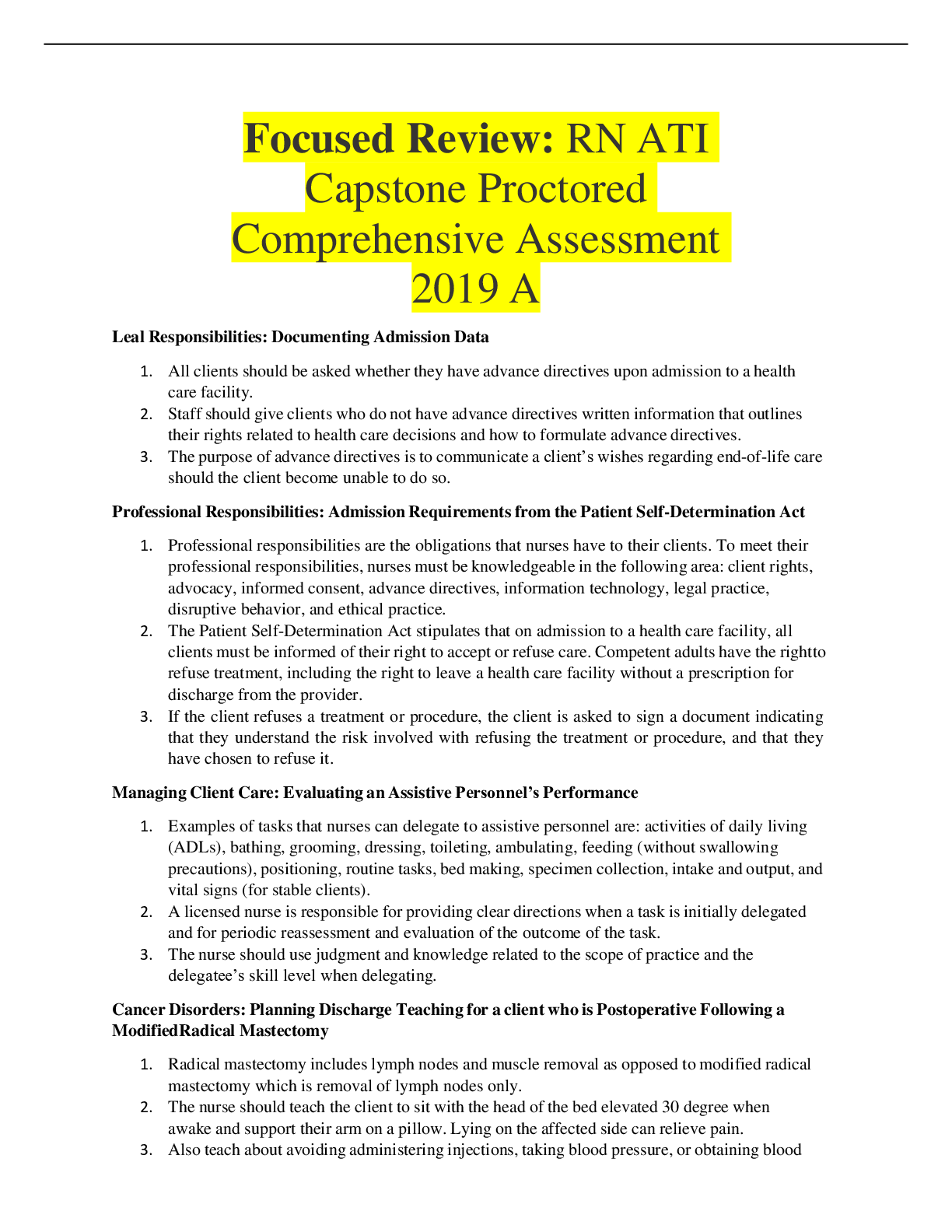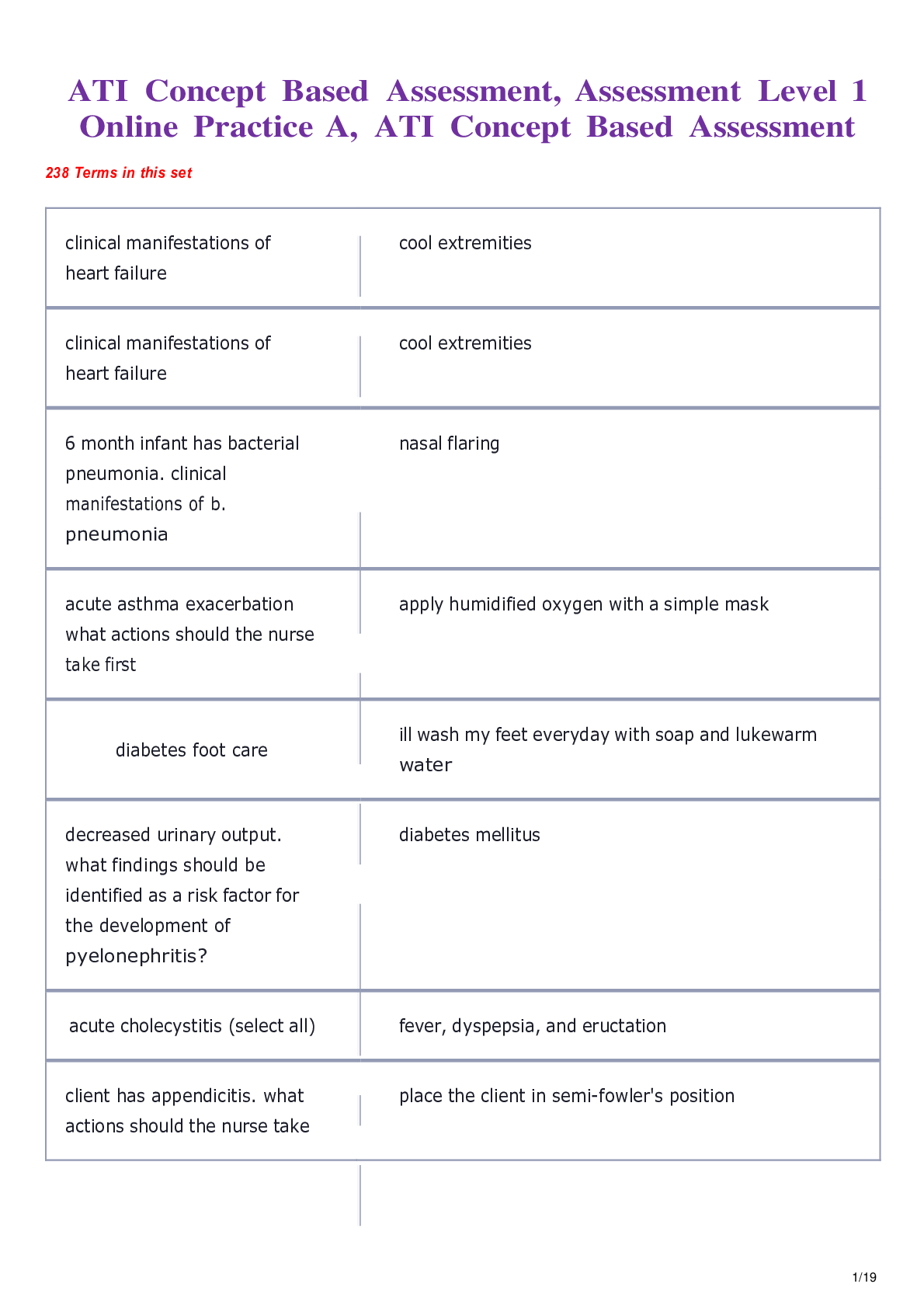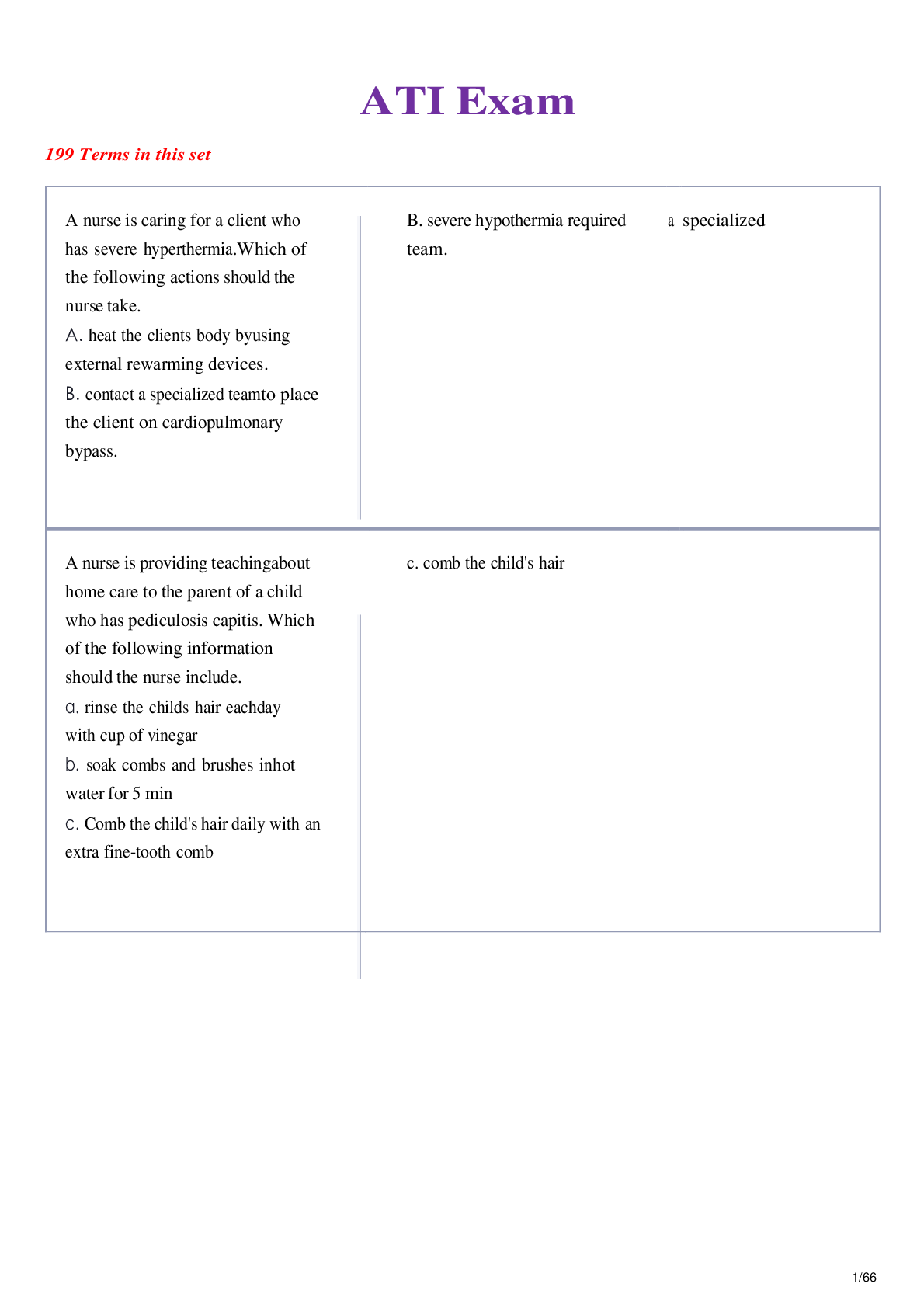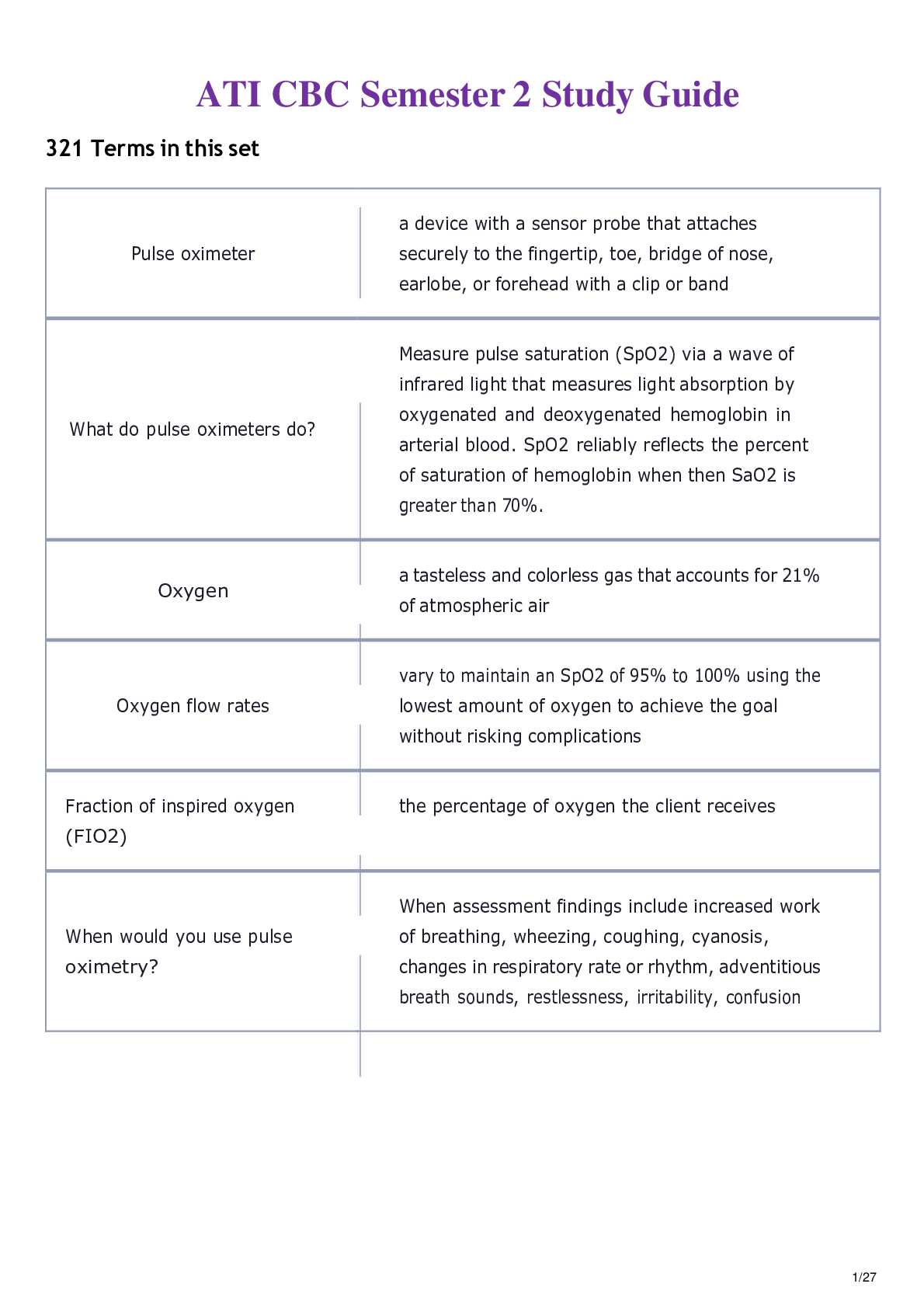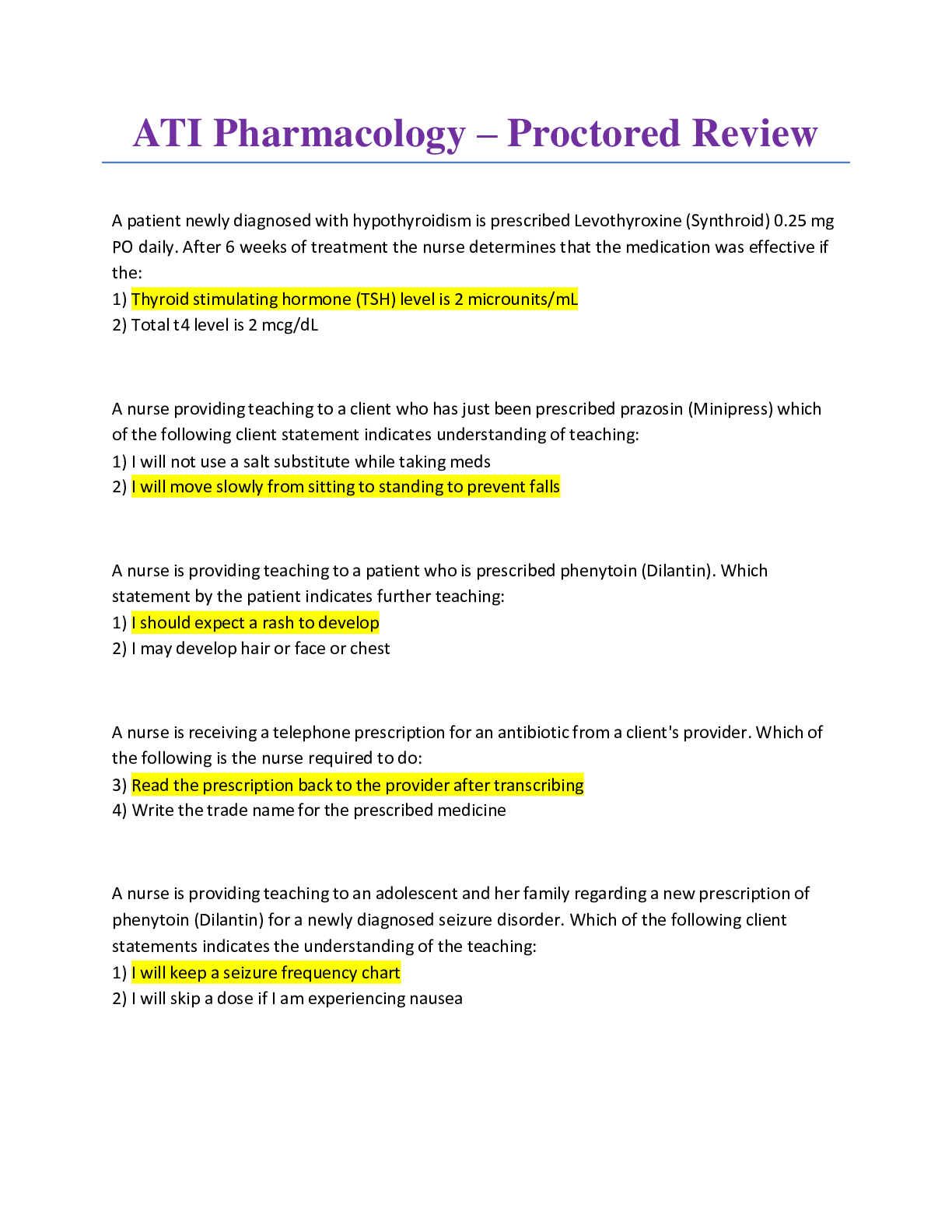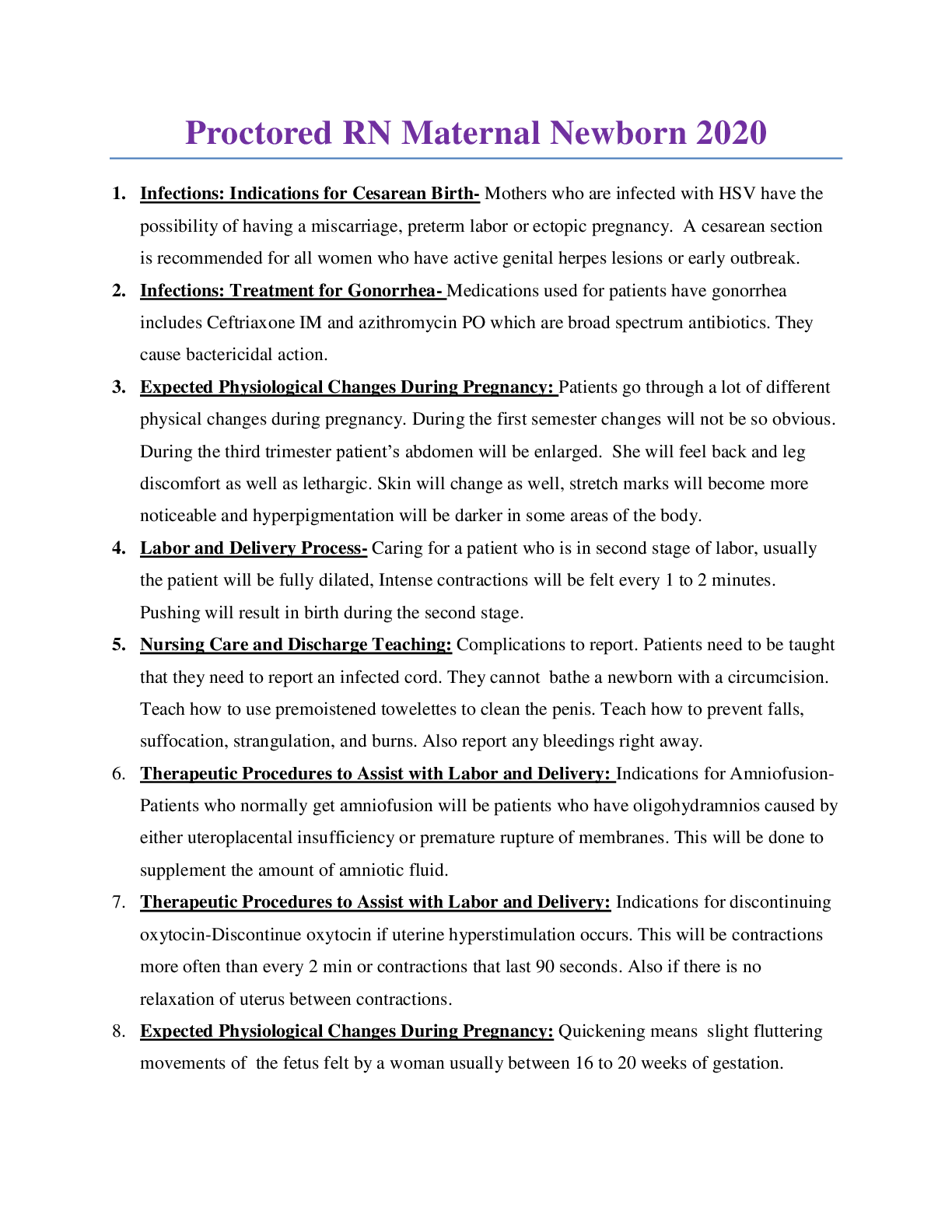*NURSING > QUESTIONS and ANSWERS > OB Maternal Newborn ATI Exam Study Guide (All)
OB Maternal Newborn ATI Exam Study Guide
Document Content and Description Below
OB Maternal Newborn ATI Exam Study Guide Video #1: Contraception & Infertility Diaphragms: client must be refitted for a diaphragm for the following conditions: 1. It’s been 2 years since she... has been fitted 2. Gained more than 15 pounds (7kg) 3. Had a full-term pregnancy 4. Had a second term abortion o When you use a diaphragm, you need to use spermicide with every act of coitus (withdrawal of penis from vagina prior to ejaculation). Every time you withdrawal, instill more spermicide. o Diaphragm must stay inserted for 6hrs after act of coitus. Hormonal Contraceptives (Oral) o Side effects: Chest pain, SOB, Leg pain (from a possible clot), headache or eye problems (from a stroke or hypertension) o Contraindications: Women with a history of blood clots, stroke, cardiac problems, smoker, breast or estrogen related cancers (pill contains estrogen) Depo-Provera/Medroxyprogesterone o Injectable progestin o Can cause decreased bone mineral density or loss of calcium Nursing action: Ensure patient has adequate intake of calcium and vitamin D IUD o Increase risk for PID o Can cause uterine perforation or ectopic pregnancy (increases risk for ectopic pregnancy) o Look out for/Notify PCP: Change in string length IUD is moving and not in the right place Foul smelling vaginal discharge Pain with intercourse Fever/Chills (infection) Infertility is defined as an inability to conceive desire engaging in unprotected sexual intercourse for a prolonged period of time or at least 12 months. Common factors associated with infertility include: o Decreased sperm production (Sperm analysis) o Endometriosis o Ovulation disorders o Tubal occlusions If you test and use DYE (used in the fallopian tubes), make sure the woman is not allergic to iodine or shellfish/seafood Video #2: Signs of Pregnancy Presumptive: Can be defined by things/reasons other than pregnancy Amenorrhea Can be anorexic or exercising too much Fatigue Didn’t sleep well Nausea/Vomiting Sick Urinary Frequency UTI Quickening/Fluttering in stomach Gas@ShopWithKey on Etsy 2 Probable: Changes that make the examiner suspect a woman is pregnant (primarily related to physical changes of the uterus). Abdominal enlargement: Related to changes in uterine size, shape, and position Hegar’s Sign: Softening and compressibility of the lower uterus Chadwick’s Sign: Deepend violet bluish color of cervix and vaginal mucosa Goodell’s Sign: Softening of cervical tip Ballottement: Rebound of unengaged uterus Braxton Hicks Contractions: False contractions that are painless, irregular, and usually relieved by walking Positive Pregnancy Test: Woman’s hormonal level may not be normal Fetal Outline: Positive: Very distinct things. Fetal Heart Sounds Fetal Heartbeat can be heard Can see the baby with ultrasound Can feel movement in the uterus Naegele’s Rule: Last menstrual period minus (– ) 3 months + 7 days + 1-year ;Cathy’s Rule: + 9 months + 1 week Gravidity and Parity: Gravida: a woman who is pregnant Gravidity: number of pregnancies o Nulligravida: a woman who has never been pregnant o Primigravida: a woman who is pregnant for the first time o Multigravida: a woman in at least her second pregnancy. Parity: the number of births (not the number of fetuses [ex: twins]) carried pat 20 weeks gestation, whether or not the fetus was born alive. o Nullipara: a woman who has not had a birth at more than 20 weeks of gestation. o Primipara: a woman who has had one birth that occurred after 20 weeks of gestation. o Multipara: a woman who has had two or more pregnancies to the stage of fetal viability. Know how to find out GTPAL numbers: G= Gravidity (# of times a woman has been pregnant PLUS current pregnancy) T= Term Births (How many babies were delivered at term 38 WEEKS OR MORE) P= Preterm Births (Below 38 weeks) A= Abortion (spontaneous or not) or miscarriages L= Living children Fundal height: Measured to evaluate the gestational age of the fetus. During the second and third trimesters (weeks 18-30), the fundal height in centimeters approximately equals the fetus’s age in weeks, plus or minus 2 cm. At 16 weeks, the fundus can be found approximately halfway between the symphysis pubis and the umbilicus.@ShopWithKey on Etsy 3 At 20 to 22 weeks, the fundus is approximately at the location of the umbilicus. At 36 weeks, the fundus is at the xiphoid process. * When assessing fundal height, monitor the client closely for supine hypotension when place in the supine position. Measuring fundal height: 1. Place the client in a supine position 2. Place the end of the tape measure at the level of symphysis pubis 3. Stretch the tape to the tope of the uterine fundus 4. Note and record the measurement. Physiological Maternal Changes: Cardiovascular system: Circulating blood volume increases by approximately 40 – 50%; physiological anemia may occur as the plasma increase exceeds the increase in the production of red blood cells. Heart size is increased, and the heart is elevated upward and to the left because of displacement of the diaphragm as the uterus enlarges. There is an increase in the body’s demand for iron. Sodium and water retention may occur, which can lead to weight gain. Respiratory system: Oxygen consumption increases by approximately 15% to 20% Diaphragm is elevated as a result of the enlarged uterus Shortness of breath may be experienced. * During pregnancy, a woman’s pulse rate may increase about 10 to 15 beats/minute, the blood pressure slightly decreases in the second trimester, then increases in the third trimester but not above the pregnancy level; and the respiratory rate remains unchanged or slightly increases. Gastrointestinal System: Nausea and vomiting, which usually subsides by the 3rd month, may occur as a result of the secretion of human chorionic gonadotropin (hCG); hCG stabilizes or decreases around week 12 Poor appetite may occur because of decreased gastric motility. Alterations in taste and smell may occur. Constipation may occur because of an increase in progesterone production or pressure of the uterus, resulting in decreased GI motility.@ShopWithKey on Etsy 4 Flatulence and heartburn may occur because of decreased GI motility and slowed emptying of the stomach cause by an increase in progesterone production. Gum tissue may become swollen and easily bleed because of increasing levels of estrogen. Ptyalism (excessive secretion of saliva) may occur because of increasing levels of estrogen. Renal System: Frequency of urination increases in the 1st and 3rd trimesters because of increased bladder sensitivity and pressure of the enlarging uterus on the bladder, Decreased bladder tone may occur and is caused by an increase in progesterone and estrogen levels; bladder capacity increases in response to increasing levels of progesterone. The renal threshold fir glucose may be reduced. Reproductive system: 1. Uterus a) Uterus enlarges, increasing in mass from approximately 60 g to 1000 g as a result of hyperplasia (influence of estrogen) and hypertrophy. b) Size and number of blood vessels and lymphatics increase c) Irregular contractions occur, typically beginning after 16 weeks gestation. 2. Cervix a) Cervix becomes shorter, more elastic, and larger in diameter. b) Endocervical glands secrete a thick mucus plug, which is expelled from the canal when dilation begins. c) Increased vascularization and an increase in estrogen causes a softening and a violet discoloration (Chadwick’s sign), which occurs at about week 6. 3. Ovaries a) Secrete progesterone for first 6 to 7 weeks of pregnancy b) Block maturation of new follicles c) Cease ovum production. 4. Vagina a) Hypertrophy and thickening of the muscle occurs. b) Increase in vaginal secretions is experienced: secretions are usually, thick, white, and acidic. 5. Breasts a) Breast changes occur because of the increasing effects of estrogen and progesterone b) Breast size increases and breasts may be tender. c) Nipples become more pronounced and the areolae become darker. d) Superficial veins become prominent e) Montgomery’s follicles become hypertrophied f) Colostrum may leak from the breasts. Skin: Changes in skin occur because of increased levels of melanocyte-stimulating hormone, which increase secondary ot increases in estrogen and progesterone; these changes include the following: a) Increased pigmentation b) Dark streak down the midline of the abdomen may appear (linea nigra).@ShopWithKey on Etsy 5 [Show More]
Last updated: 2 years ago
Preview 1 out of 23 pages
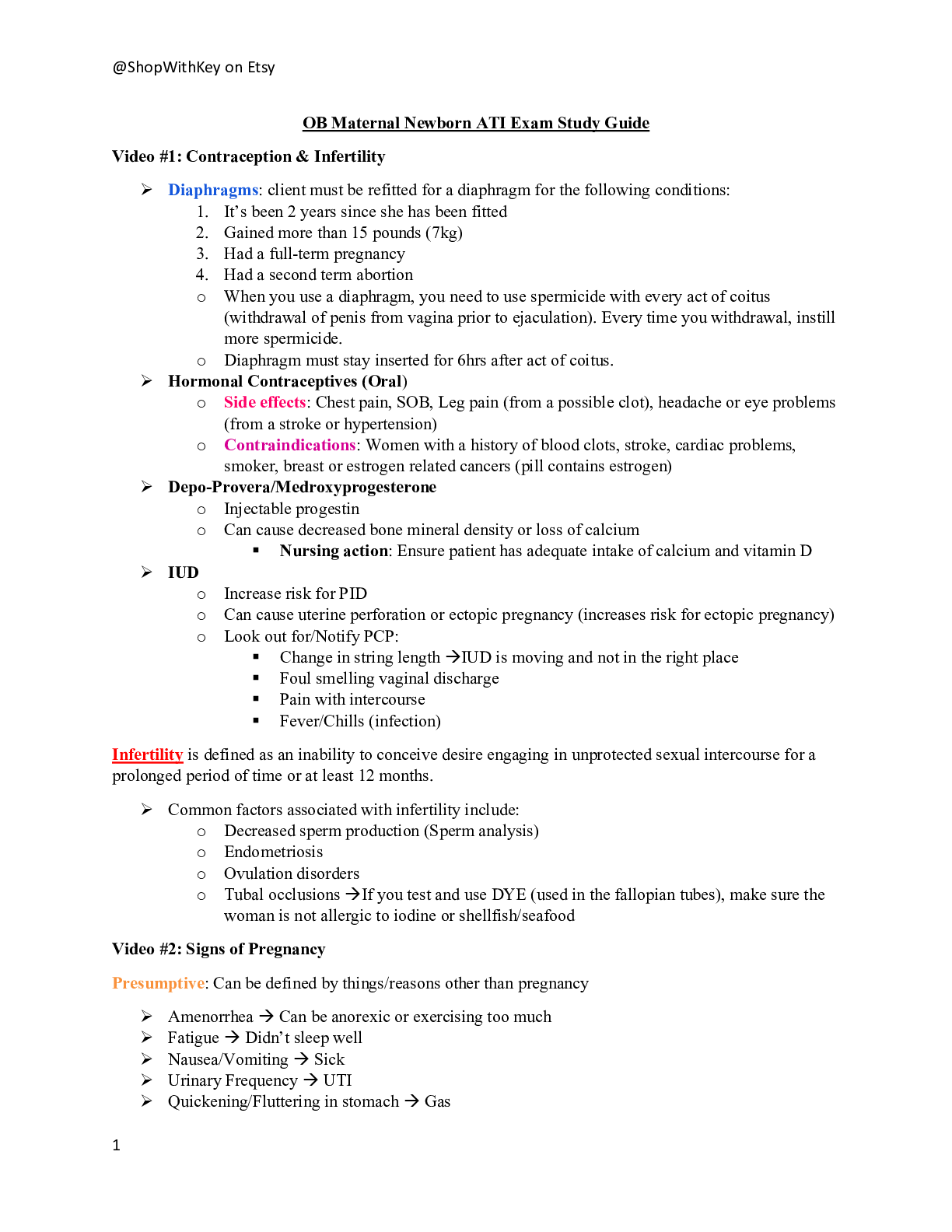
Buy this document to get the full access instantly
Instant Download Access after purchase
Buy NowInstant download
We Accept:

Reviews( 0 )
$12.00
Can't find what you want? Try our AI powered Search
Document information
Connected school, study & course
About the document
Uploaded On
Feb 09, 2021
Number of pages
23
Written in
Additional information
This document has been written for:
Uploaded
Feb 09, 2021
Downloads
0
Views
96

